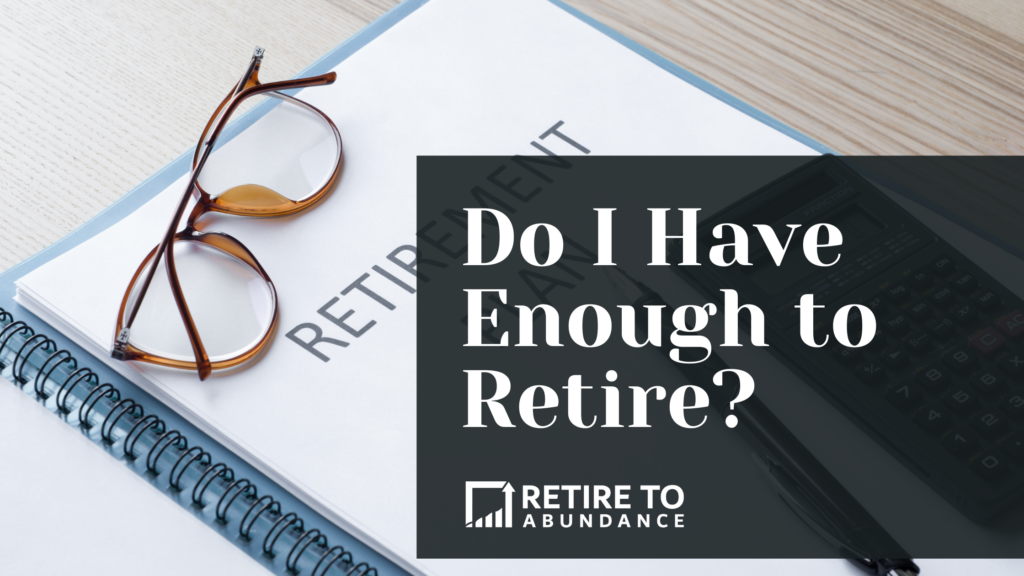Retirement is a time of life that many people look forward to. After years of hard work, it’s time to relax and enjoy the fruits of your labor. However, before you can truly enjoy retirement, it is important to answer the simple question that most keeps pre-retirees up at night: Do I have enough to retire? While certainly the answer can be complex and nuanced, it still simply comes down to income and expenses. Namely if your projected income exceeds your projected expenses then you have enough to retire.
The Importance of Having a Plan
While most people would agree that having a retirement plan is important, there seems to be some confusion about what exactly constitutes a retirement plan. Let’s take a moment to clarify what does not qualify as a retirement plan. A 401k, Social Security, or simply picking out the date of your retirement are not a retirement plan in themselves. Although each of these is a key component, relying solely on them will likely leave you feeling anxious and uncertain about your retirement.
A comprehensive retirement plan should include an income plan that maximizes Social Security benefits, ensures that you’re not overspending or underspending in retirement, and establishes the appropriate asset allocation. It should also explore tax strategies, forecast medical expenses (including long-term care), and make provisions for high-impact contingencies such as high inflation or the unexpected death of a spouse. A well thought out and executed retirement plan gives retirees the confidence they need to truly enjoy retirement.
Determining Expenses
In his book “Don’t Worry, Retire Happy” retirement planning expert Tom Hegna identifies two simple yet critical questions to ask as you approach retirement:
What do I need my retirement income to do?
What do I want my retirement income to do?
Fortunately, the answer to the first question is pretty clear and simple to get to…We NEED our retirement income to provide for our basic living expenses. We can get to this through simple tracking and forecasting. It is for this reason I recommend that my clients track their expenses for at least one year preceding their retirement. While some experts recommend a percent of your current income (anywhere from 60% to 80% depending on the “expert” who is talking), I find these rules of thumb to be disingenuous and not a good basis when retirement planning on a personalized basis. If you can track your expenses for an entire year ahead of time, that is long enough to catch the one-off annual payments such as car insurance or property taxes, and you can go through and pick out any expenses that will go away in retirement such as professional membership dues or tools needed for your job. As a quick aside, I do recognize that many people wait to start planning their retirement, or at least wait to engage with a planner until their retirement date is much closer. If you are one of these people, the key is to get started as soon as possible. Better data leads to better projections, which leads to higher levels of confidence.
Now that we have our first question answered, the fun part can start! Once we’ve made sure the basic needs are covered, it is time to start answering the question of what I WANT my retirement income to do. In my experience many people spend time on this at a very high level but have not thought about it down to the detail. Many clients will give me responses such “I want to travel” or “I want to be generous”. While those are certainly good goals, they are too broad to actually plan towards. Being specific and intentional with what you want to accomplish in retirement not only aids in the planning process but significantly increases the likelihood of achieving those goals.
Knowing your expenses is half the equation. Figuring out the income piece comes next.
Fitting Income to Expenses
Once we have a clear picture of what our needs and wants are in retirement we can start to match up income and expenses. When building out a retirement income plan there are three different categories of income that we evaluate.
1. Guaranteed Lifetime Income
Social Security – While there have been entire books written about maximizing your social security benefits, I will spare you the details here and simply say that getting this decision wrong can cost you in excess of $100,000 and the normal coffee shop wisdom on this is typically wrong.
Pensions – Pensions are becoming less prevalent, but there are a handful still floating around, particularly if you are a civil servant employed by the local, state, or federal government. Much like your social security claiming strategy, making your decision on when to claim and, if married, which option to claim can have an outsized impact on your retirement. It is certainly worth it to engage with a financial professional prior to making any elections on your pension because often times pairing your pension election with other financial products can lead to an increase in retirement income.
Annuities – Specifically we are talking about lifetime income annuities when discussing guaranteed lifetime income. Annuities have gotten a bad reputation at times and somehow have found a way to simultaneously be undersold and oversold. Without getting into too big of debate on the pros and cons of annuities, I will simply state here that they are the only financial product that exists that can take your savings and produce a stream of guaranteed lifetime income. For the right person and situation, they can provide the safety and security needed to reduce stress in retirement.
2. Semi-Guaranteed Lifetime Income
Rental Real Estate – Rental income in retirement can provide a steady (and inflation protected) stream of income that should stand the test of time. It is certainly worth evaluating the pitfalls particularly if you are going to manage the rentals yourself. While this form of income has certainly stood the test of time, you must recognize the risks associated with keeping the property maintained as well as the risk of vacancies and build in appropriate margins to address these risks when they inevitably come about. A subset of rental real estate is the rent of farm ground. A question that comes up quite frequently is whether to cash rent or crop share. Being on the planning side, I like the predictability of cash rent, but I am sympathetic towards those who gravitate towards crop sharing. It is important to note that this is not an either-or decision and I know of landowners who have successfully done a portion in each, and this has given them a portion of very predictable income while still maintaining the upside potential inherent with shares.
3. Portfolio Income
Portfolio income refers to the income received from your investment portfolio. While we do have some ways to turn portfolio income into guaranteed lifetime income via a lifetime income annuity, that is not what we are discussing in this section.
The 4% Rule – The 4% rule is the rule of thumb that states that you take 4% of your portfolio’s value as the basis for your withdrawals. You are then able to adjust it for inflation in each of the subsequent years of retirement. This rule was based on Bill Bengen’s research in the mid-1990s based on historical data of the stock market. While I think this makes for an excellent rule of thumb, in practice it is an over-simplification and does not account for the behavioral economics that allow for the higher withdrawal rate discussed below.
Retirement Income Guardrails Strategy– What sets apart the retirement income guardrails strategy from the above 4% rule is its inherent dynamic nature. While the 4% rule is generally easier to understand and thus the more discussed withdrawal strategy, retirement income guardrails allow you to start with a much higher withdrawal rate to begin with. Based on financial advisor Jonathan Guyton’s and professor William Klinger’s research, the retirement income guardrails strategy allows you to increase your withdrawals when the market does well, but requires you to decrease or tighten your belt if your portfolio falls below a specified metric. This is the method most often used in our office as it is my belief that it more closely resembles our work history with our spending expanding during the good times and contracting during the poor times.
Learn more about Retirement Income Guardrails here: Guardrails Approach: A Flexible Retirement Withdrawal Strategy (cnbc.com)
The Dangers of a Just in Case Retirement
Decisions made around retirement are among the most impactful decisions of our entire lives, and it is my mission to ensure that you avoid the “just in case retirement.” You know, that retirement that keeps the mattress stuffed full of cash “just in case”. The retirement that leads you to never checking off the items on your bucket list because of the “what ifs” that are inherent to life. It is our goal to help you live the retirement of your dreams by utilizing the wisdom of the research to craft a plan that allows you to spend your money without fear of outliving it. Retirement planning is my passion. If you are searching for peace of mind surrounding your retirement, contact me today to get started on your personalized retirement plan.
This post is for educational and entertainment purposes only. Nothing should be construed as investment, tax, or legal advice.

